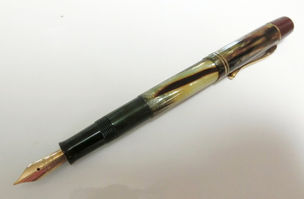top of page
Pelikan 101N⁽¹⁾ (ca.1949)
In April 1945, the Allied ground advance into Germany reached Hanover. On April 10, 1945, the US 84th infantry division captured the city.After WWII, Hanover was in the British zone of occupation of Germany. The delivery of finished pens was limited by the military government's headquarters, and exporting finished pens and spare parts were frozen.
In February, 1946, the machinery had not yet been fully repaired. On the contrary, the company planed to relocate the injection molding machinery to another division (packaging division). Mr. Kovàcs fought against the plan as delay in resumption of production would lead to delay in his income from his royalties. The company shelved the plan fearing that he would offer his patens to foreign manufacturers, and put more energy into getting production started up again.
Finally, in 1947, the supply of model 100N with CN nib was resumed for the domestic market but in limited quantity (Pelikan Schreibgeräte).
As from October, 1948, 1ooN with gold nib were allowed to be produced for the export market.
In 1949, the grip section with step was replaced by a smooth grip section. It seems that Günter Wagner concluded that the step was unnecessary in terms of ergonomics or visual sense. With this modification, model 100N moved to the 4th generation.
As from July 4, 1949, pens with gold nib were allowed to be produced for the domestic market. But, the purchaser had to supply used nibs in exchange.At the end of 1949, gold nibs became available without exchanging used nibs. CN nibs were still available.
Before World War II, Günter Wagner also made the model 101N with a colored cap and sleeve, but after the war it appears that only the 101N with a tortoiseshell cap and sleeve was revived (the cap tops were only made of red ebonite instead of celluloid)(@stoen)⁽¹⁾
Green indicates the points that differ from Pelikan 100N (ca.1942).
Cap top; material: cellulose acetate, shape: conical, flat cap top edge, logo: new two chicks logo on the top and “GÜNTER WAGER Pelikan” on the lateral side.
Cap tube; material: cellulose acetate, shape: no vent holes, two narrow bands, grooved around the inner wall.
Clip; shape: gold plated drop clip.
Nib; material: 14 ct gold, shape: round vent hole, logo:
Pelikan
585
14 KARAT
S⁽²⁾
Feed; material: ebonite, shape: flat tail, three lamellae without the recess.
Nib socket; material: ebonite, shape: 13.5 mm.
Grip section and barrel; material: one piece injection molded transparent acrylics, shape; flat top edge, slightly tapered, no brass ring, step near the thread was abolished.
Sleeve; material: cellulose acetate.
Filling system; material: injection molded acrylics with black elastomer, shape: conical, smooth turning knob.
Dimensions;
Judging from the nib unit and section, my pen can be attributed to the fourth generation. It is not in a good condition, but tells me how it was build up. As I told before, the barrel was coated with white paint in some model 101Ns, so that the barrel color would not show through. As a result, the sleeve looked brighter and something like "mother of pearl" in some pens. As seen in Fig.4, white paint has come off or degraded from the grip-side portion, where it looks darker and original tortoiseshell color. My pen can be dated around 1938, belonging to the first generation.
Note;⁽¹⁾According to @stoen, the naming was inconsistent between the pre- and post-war periods, and after the war, all 101N-like pens with red/brown caps seem to have been sold under the name of "100N"(Fig.5).
⁽²⁾"S" stands for "Scheiben-spitze" (Pelikan-collectibles).
My collection except for Fig.5.
bottom of page




